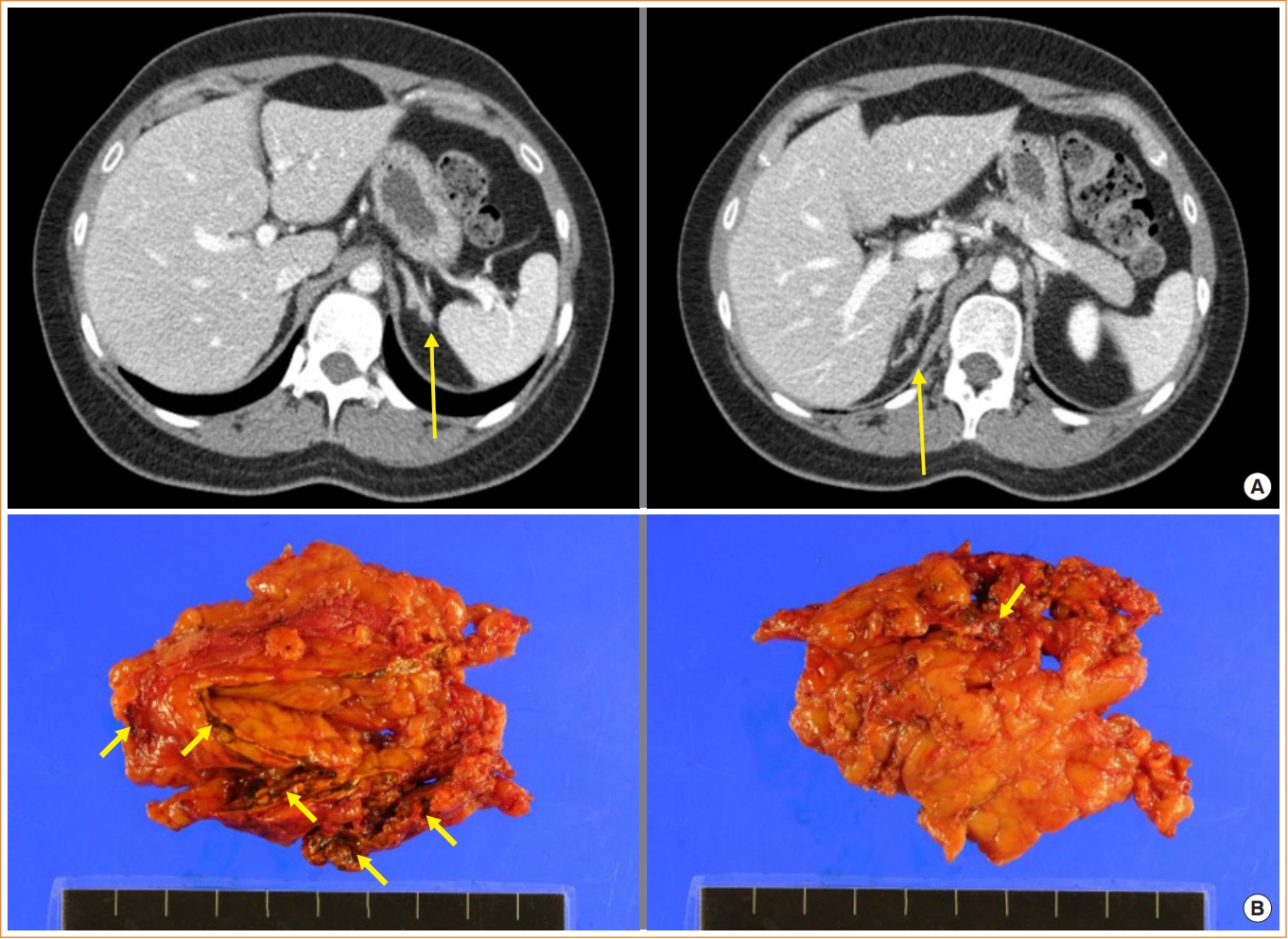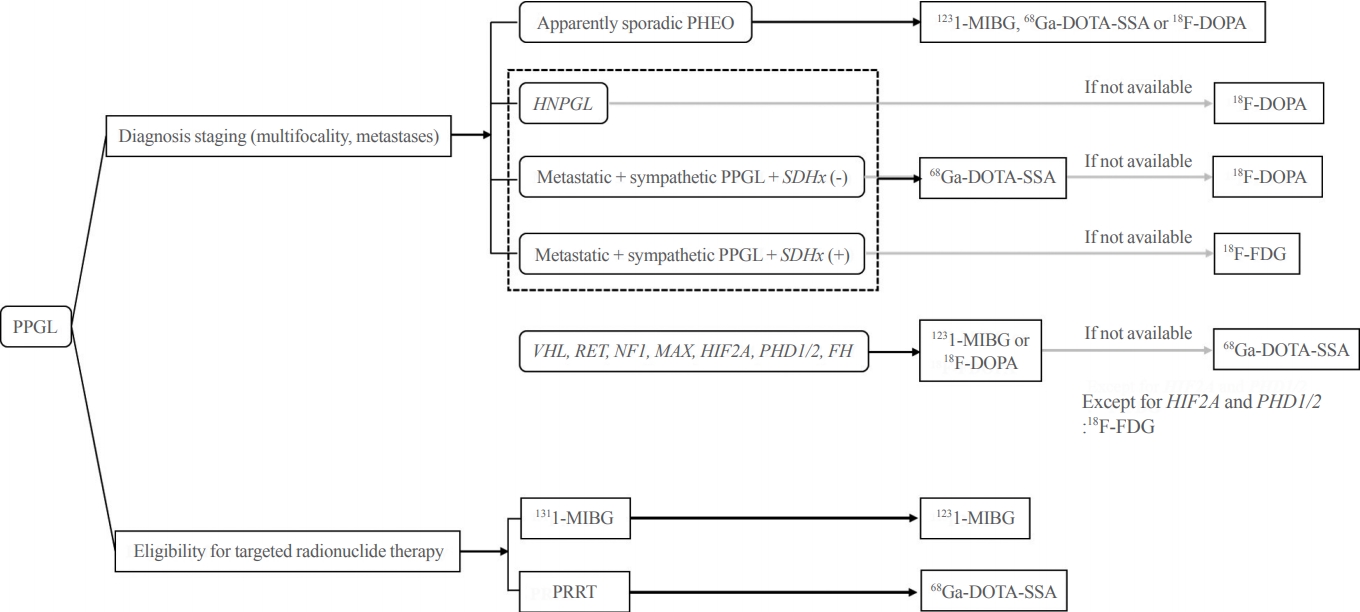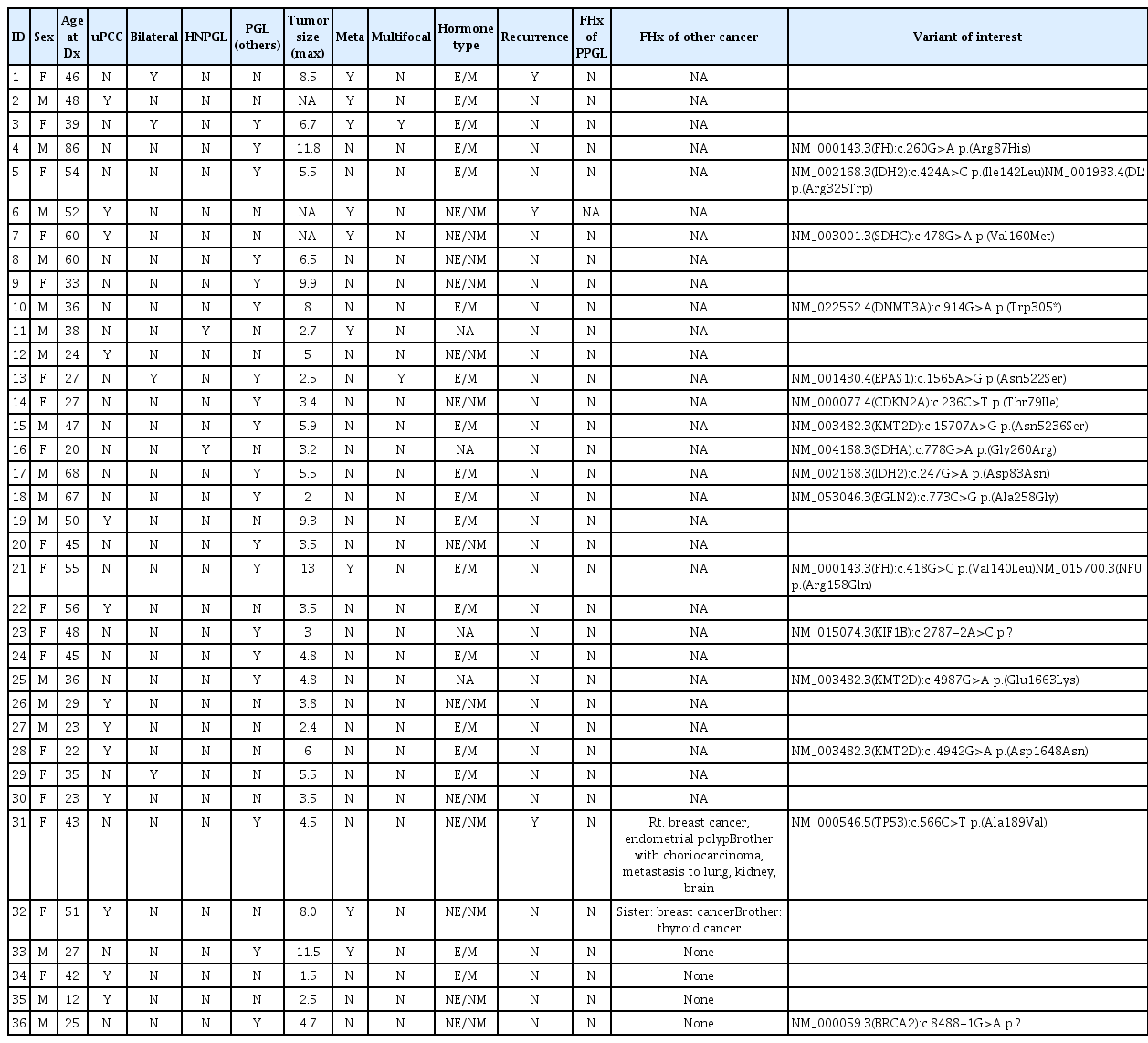Search
- Page Path
- HOME > Search
Brief Report
- Adrenal Gland
- A Novel Missense PRKAR1A Variant Causes Carney Complex
- Boram Kim, Han Na Jang, Kyung Shil Chae, Ho Seop Shin, Yong Hwy Kim, Su Jin Kim, Moon-Woo Seong, Jung Hee Kim
- Endocrinol Metab. 2022;37(5):810-815. Published online October 4, 2022
- DOI: https://doi.org/10.3803/EnM.2022.1544

- 1,840 View
- 153 Download
- 1 Web of Science
- 1 Crossref
-
 Abstract
Abstract
 PDF
PDF Supplementary Material
Supplementary Material PubReader
PubReader  ePub
ePub - The Carney complex (CNC) is an autosomal dominant disorder characterized by endocrine and nonendocrine tumors. Loss-of-function variants of protein kinase A regulatory subunit 1 alpha (PRKAR1A) are common causes of CNC. Here, we present the case of a patient with CNC with a novel PRKAR1A missense variant. A 21-year-old woman was diagnosed with CNC secondary to acromegaly and adrenal Cushing syndrome. Genetic analysis revealed a novel missense heterozygous variant of PRKAR1A (c.176A>T). Her relatives, suspected of having CNC, also carried the same variant. RNA analysis revealed that this variant led to nonsense-mediated mRNA decay. In vitro functional analysis of the variant confirmed its role in increasing protein kinase A activity and cyclic adenosine monophosphate levels. This study broadens our understanding of the genetic spectrum of CNC. We suggest that PRKAR1A genetic testing and counseling be recommended for patients with CNC and their families.
-
Citations
Citations to this article as recorded by- Carney complex: A clinicopathologic study on a single family from several Canadian provinces
Alexandra Lao, Julio Silva, Brian Chiu, Consolato M. Sergi
Cardiovascular Pathology.2024; 69: 107599. CrossRef
- Carney complex: A clinicopathologic study on a single family from several Canadian provinces

Special Article
- Adrenal gland
- Diagnosis for Pheochromocytoma and Paraganglioma: A Joint Position Statement of the Korean Pheochromocytoma and Paraganglioma Task Force
- Eu Jeong Ku, Kyoung Jin Kim, Jung Hee Kim, Mi Kyung Kim, Chang Ho Ahn, Kyung Ae Lee, Seung Hun Lee, You-Bin Lee, Kyeong Hye Park, Yun Mi Choi, Namki Hong, A Ram Hong, Sang-Wook Kang, Byung Kwan Park, Moon-Woo Seong, Myungshin Kim, Kyeong Cheon Jung, Chan Kwon Jung, Young Seok Cho, Jin Chul Paeng, Jae Hyeon Kim, Ohk-Hyun Ryu, Yumie Rhee, Chong Hwa Kim, Eun Jig Lee
- Endocrinol Metab. 2021;36(2):322-338. Published online April 6, 2021
- DOI: https://doi.org/10.3803/EnM.2020.908

- 7,504 View
- 572 Download
- 8 Web of Science
- 10 Crossref
-
 Abstract
Abstract
 PDF
PDF PubReader
PubReader  ePub
ePub - Pheochromocytoma and paraganglioma (PPGLs) are rare catecholamine-secreting neuroendocrine tumors but can be life-threatening. Although most PPGLs are benign, approximately 10% have metastatic potential. Approximately 40% cases are reported as harboring germline mutations. Therefore, timely and accurate diagnosis of PPGLs is crucial. For more than 130 years, clinical, molecular, biochemical, radiological, and pathological investigations have been rapidly advanced in the field of PPGLs. However, performing diagnostic studies to localize lesions and detect metastatic potential can be still challenging and complicated. Furthermore, great progress on genetics has shifted the paradigm of genetic testing of PPGLs. The Korean PPGL task force team consisting of the Korean Endocrine Society, the Korean Surgical Society, the Korean Society of Nuclear Medicine, the Korean Society of Pathologists, and the Korean Society of Laboratory Medicine has developed this position statement focusing on the comprehensive and updated diagnosis for PPGLs.
-
Citations
Citations to this article as recorded by- A Prospective Comparative Study of 18F-FDOPA PET/CT Versus 123I-MIBG Scintigraphy With SPECT/CT for the Diagnosis of Pheochromocytoma and Paraganglioma
Changhwan Sung, Hyo Sang Lee, Dong Yun Lee, Yong-il Kim, Jae Eun Kim, Sang Ju Lee, Seung Jun Oh, Tae-Yon Sung, Yu-Mi Lee, Young Hoon Kim, Beom-Jun Kim, Jung-Min Koh, Seung Hun Lee, Jin-Sook Ryu
Clinical Nuclear Medicine.2024; 49(1): 27. CrossRef - Evaluation and Management of Bone Health in Patients with Thyroid Diseases: A Position Statement of the Korean Thyroid Association
A Ram Hong, Ho-Cheol Kang
Endocrinology and Metabolism.2023; 38(2): 175. CrossRef - Lesion-based indicators predict long-term outcomes of pheochromocytoma and paraganglioma– SIZEPASS
Helena Hanschell, Salvador Diaz-Cano, Alfredo Blanes, Nadia Talat, Gabriele Galatá, Simon Aylwin, Klaus Martin Schulte
Frontiers in Endocrinology.2023;[Epub] CrossRef - Interleukin-6-producing paraganglioma as a rare cause of systemic inflammatory response syndrome: a case report
Yin Young Lee, Seung Min Chung
Journal of Yeungnam Medical Science.2023; 40(4): 435. CrossRef - (Extremely rare intrapericardial location of paraganglioma)
Jaroslav Zajíc, Aleš Mokráček, Ladislav Pešl, Jiří Haniš, Dita Schaffelhoferová
Cor et Vasa.2023; 65(4): 692. CrossRef - A Case of Von Hippel-Lindau Disease With Recurrence of Paraganglioma and No Other Associated Symptoms: The Importance of Genetic Testing and Establishing Follow-Up Policies
Naoki Okada, Akihiro Shioya, Sumihito Togi, Hiroki Ura, Yo Niida
Cureus.2023;[Epub] CrossRef - KSNM60 in Nuclear Endocrinology: from the Beginning to the Future
Chae Moon Hong, Young Jin Jeong, Hae Won Kim, Byeong-Cheol Ahn
Nuclear Medicine and Molecular Imaging.2022; 56(1): 17. CrossRef - Change of Computed Tomography-Based Body Composition after Adrenalectomy in Patients with Pheochromocytoma
Yousun Ko, Heeryoel Jeong, Seungwoo Khang, Jeongjin Lee, Kyung Won Kim, Beom-Jun Kim
Cancers.2022; 14(8): 1967. CrossRef - Evaluation and Management of Bone Health in Patients with Thyroid Diseases: a Position Statement from the Korean Thyroid Association
A Ram Hong, Hwa Young Ahn, Bu Kyung Kim, Seong Hee Ahn, So Young Park, Min-Hee Kim, Jeongmin Lee, Sun Wook Cho, Ho-Cheol Kang
International Journal of Thyroidology.2022; 15(1): 1. CrossRef - Pheochromocytoma with Retroperitoneal Metastasis: A Case Report
建新 崔
Advances in Clinical Medicine.2021; 11(05): 2239. CrossRef
- A Prospective Comparative Study of 18F-FDOPA PET/CT Versus 123I-MIBG Scintigraphy With SPECT/CT for the Diagnosis of Pheochromocytoma and Paraganglioma

Original Article
- Clinical Study
- Whole Exome Sequencing Identifies Novel Genetic Alterations in Patients with Pheochromocytoma/Paraganglioma
- Soo Hyun Seo, Jung Hee Kim, Man Jin Kim, Sung Im Cho, Su Jin Kim, Hyein Kang, Chan Soo Shin, Sung Sup Park, Kyu Eun Lee, Moon-Woo Seong
- Endocrinol Metab. 2020;35(4):909-917. Published online December 23, 2020
- DOI: https://doi.org/10.3803/EnM.2020.756

- 5,256 View
- 156 Download
- 10 Web of Science
- 8 Crossref
-
 Abstract
Abstract
 PDF
PDF Supplementary Material
Supplementary Material PubReader
PubReader  ePub
ePub - Background
Pheochromocytoma and paragangliomas (PPGL) are known as tumors with the highest level of heritability, approximately 30% of all cases. Clinical practice guidelines of PPGL recommend genetic testing for germline variants in all patients. In this study, we used whole exome sequencing to identify novel causative variants associated with PPGL to improve the detection of rare genetic variants in our cohort.
Methods
Thirty-six tested negative for pathogenic variants in previous Sanger sequencing or targeted gene panel testing for PPGL underwent whole exome sequencing. Whole exome sequencing was performed using DNA samples enriched using TruSeq Custom Enrichment Kit and sequenced with MiSeq (Illumina Inc.). Sequencing alignment and variant calling were performed using SAMtools.
Results
Among previously mutation undetected 36 patients, two likely pathogenic variants and 13 variants of uncertain significance (VUS) were detected in 32 pheochromocytoma-related genes. SDHA c.778G>A (p.Gly260Arg) was detected in a patient with head and neck paraganglioma, and KIF1B c.2787-2A>C in a patient with a bladder paraganglioma. Additionally, a likely pathogenic variant in BRCA2, VUS in TP53, and VUS in NFU1 were detected.
Conclusion
Exome sequencing further identified genetic alterations by 5.6% in previously mutation undetected patients in PPGL. Implementation of targeted gene sequencing consisted of extended genes of PPGL in routine clinical screening can support the level of comprehensive patient assessment. -
Citations
Citations to this article as recorded by- Patient Sex and Origin Influence Distribution of Driver Genes and Clinical Presentation of Paraganglioma
Susan Richter, Nicole Bechmann
Journal of the Endocrine Society.2024;[Epub] CrossRef - Case Report: Aggressive neural crest tumors in a child with familial von Hippel Lindau syndrome associated with a germline VHL mutation (c.414A>G) and a novel KIF1B gene mutation
Lucie Landen, Anne De Leener, Manon Le Roux, Bénédicte Brichard, Selda Aydin, Dominique Maiter, Philippe A. Lysy
Frontiers in Endocrinology.2023;[Epub] CrossRef - A Case of Pheochromocytoma as a Subsequent Neoplasm in a Survivor of Childhood Embryonal Rhabdomyosarcoma
Rozalyn L. Rodwin, Sanyukta K. Janardan, Erin W. Hofstatter, Nina S. Kadan-Lottick
Journal of Pediatric Hematology/Oncology.2022; 44(2): e585. CrossRef - Mutations of 1p genes do not consistently abrogate tumor suppressor functions in 1p-intact neuroblastoma
Chik Hong Kuick, Jia Ying Tan, Deborah Jasmine, Tohari Sumanty, Alvin Y. J. Ng, Byrrappa Venkatesh, Huiyi Chen, Eva Loh, Sudhanshi Jain, Wan Yi Seow, Eileen H. Q. Ng, Derrick W. Q. Lian, Shui Yen Soh, Kenneth T. E. Chang, Zhi Xiong Chen, Amos H. P. Loh
BMC Cancer.2022;[Epub] CrossRef - A case of juvenile-onset pheochromocytoma with KIF1B p.V1529M germline mutation
Masahiro Nezu, Yosuke Hirotsu, Kenji Amemiya, Miho Katsumata, Tomomi Watanabe, Soichi Takizawa, Masaharu Inoue, Hitoshi Mochizuki, Kyoko Hosaka, Toshio Oyama, Masao Omata
Endocrine Journal.2022; 69(6): 705. CrossRef - Systematic analysis of expression profiles and prognostic significance for MMDS-related iron–sulfur proteins in renal clear cell carcinoma
Ling Yang, Yu-Xin Chen, Ying-Ying Li, Xiao-Juan Liu, Yong-Mei Jiang, Jia Mai
Scientific Reports.2022;[Epub] CrossRef - Diagnosis for Pheochromocytoma and Paraganglioma: A Joint Position Statement of the Korean Pheochromocytoma and Paraganglioma Task Force
Eu Jeong Ku, Kyoung Jin Kim, Jung Hee Kim, Mi Kyung Kim, Chang Ho Ahn, Kyung Ae Lee, Seung Hun Lee, You-Bin Lee, Kyeong Hye Park, Yun Mi Choi, Namki Hong, A Ram Hong, Sang-Wook Kang, Byung Kwan Park, Moon-Woo Seong, Myungshin Kim, Kyeong Cheon Jung, Chan
Endocrinology and Metabolism.2021; 36(2): 322. CrossRef - Recurrent Germline Mutations of CHEK2 as a New Susceptibility Gene in Patients with Pheochromocytomas and Paragangliomas
Yinjie Gao, Chao Ling, Xiaosen Ma, Huiping Wang, Yunying Cui, Min Nie, Anli Tong, Dario De Biase
International Journal of Endocrinology.2021; 2021: 1. CrossRef
- Patient Sex and Origin Influence Distribution of Driver Genes and Clinical Presentation of Paraganglioma


 KES
KES

 First
First Prev
Prev



